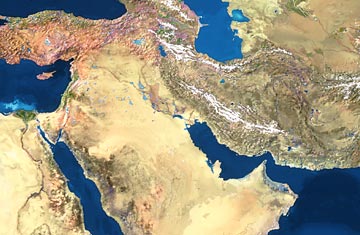
When the General Assembly of the International Atomic Energy Agency (IAEA) passed a resolution on Sept. 17 calling on Israel to join the Nuclear Non-Proliferation Treaty (NPT) and open its nuclear facilities to international inspection, Israeli officials pushed back. The resolution "is only aiming at reinforcing political hostilities and lines of division in the Middle East region," Israeli delegate David Danieli told the U.N. body. And he had a point: Israel is one of only three countries in the world that have yet to join the treaty, but the other two, India and Pakistan, weren't mentioned in the resolution — even though their conflict makes them more likely to be involved in a nuclear exchange than Israel is. Then there was the fact that the authors of the resolution were Arab countries that don't recognize Israel — and the fact that Iran's ambassador crowed that the vote was a triumph for the Palestinians.
Although it might have been missed amid the ritual posturing against Israel — versions of the same resolution have been presented annually for the past 19 years — the IAEA assembly passed a second resolution that couched the same objective in much more engaging language: a Nuclear Weapons Free Zone (NWFZ) for the Middle East. Though the idea of a NWFZ for the region has been around since the 1970s, it has largely been the preserve of leftist groups like Greenpeace or a tool for pressuring Israel, the only Middle East nation believed to have nuclear weapons. But not only was the latest NFWZ resolution supported by Israel; it could also provide a tool for defusing the conflict over Iran's nuclear program.
Israel has long maintained a policy of "strategic ambiguity" about its nuclear-weapons capability, hinting that it can deter any aggression with overwhelming force, but without inviting the international scrutiny of a fully declared program — or sparking a regional arms race. That position went largely unchallenged for some three decades. But in 2003, the IAEA accused Iran, which had started a civilian nuclear-energy program during the reign of the U.S.-backed Shah, of falling short of NPT transparency requirements. Although the IAEA has never accused Iran of trying to build a bomb, intelligence agencies in Israel and the West believe Iran is using its civilian nuclear program, particularly its uranium-enrichment capability, to assemble infrastructure that would give it the means to create nuclear weapons. The specter of a nuclear-armed Iran has, in turn, sparked interest in acquiring nuclear technology among a number of Arab countries that are wary of Iranian power. And, of course, Iran has constantly referred to Israel's nuclear program in alleging a double standard on the part of its critics.
Although representatives of six world powers — the U.S. Britain, Germany, France, Russia and China — are to meet with their Iranian counterparts in Turkey on Oct. 1 in pursuit of a diplomatic solution to the nuclear standoff, there's little optimism over the prospects for a compromise. The U.S. and European powers are demanding that Iran forgo its right to enrich uranium even for energy purposes in exchange for a series of economic and diplomatic rewards, but Tehran has ruled out renouncing that right. And Israel has repeatedly warned that if the diplomatic outreach fails, it is prepared to resort to military action to stop Iran's nuclear development.
Widening the negotiations to include the principle of a NWFZ for the Middle East could break the deadlock. Under a treaty sponsored by the IAEA, permanent inspectors and surveillance technologies could be installed in the current or future civilian nuclear-development programs of all 22 of the Arab League nations, plus Israel and Iran, backed by the threat of immediate sanctions and possible military action for any breaches of the agreement not to build weapons. This would allow Iran to save face and maintain its ostensibly civilian nuclear program and, in exchange for the decommissioning of Israeli weapons, reassure the rest of the world that Iran isn't going to get the bomb either. Former Iranian President Mohammed Khatami even floated the idea on a trip to the U.S. in 2006, but it fell on the deaf ears of the Bush Administration. If the Obama Administration revives the NWFZ, it will put pressure on current Iranian President Mahmoud Ahmadinejad, who has airily called for an end to all nuclear weapons, to get serious.
A NWFZ would be a harder sell in Israel, where the government has previously refused to discuss the issue until hostile Arab and Muslim nations recognize the Jewish state's right to exist. The new IAEA resolution that Israel nominally supported calls for the use of dialogue to achieve the end of nuclear weapons in the region, which of course can't happen as long as there are no diplomatic relations between Israel and other Middle Eastern countries.
But the prospects for a nuclear-free Middle East may not be as grim as they seem. Several incentives could yet tempt Israel onto that path. For one thing, there's strong opposition in the U.S. and Europe to a military strike, which even in the best-case scenario would simply delay Iran's progress rather than end its nuclear program — possibly at the cost of a regional war. The U.S. might offer Israel extra security guarantees, like partnership with NATO. And then there's the fact that what the Iran threat represents is a changed game; Israel isn't the only regional player to benefit from the perception that it wields a nuclear deterrent. The danger of a regional arms race creates a new and compelling fear — Arabs with nukes — that may prompt Israel to re-examine its assumptions. Still, having developed whatever nuclear capability it may possess precisely in order to give itself a strategic trump card free of dependence on allies, Israel will not easily surrender its ambiguous weapon.
